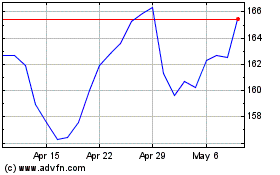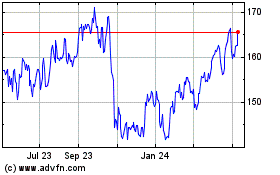By Sarah Kent
Three years into an oil price slump, investors want the world's
biggest oil companies to do something they have historically
struggled with: Maintain some financial discipline.
The companies are under pressure to show they are continuing to
move on from budget-busting projects once common in the industry,
as they head into second-quarter financial disclosures that begin
on Thursday with Royal Dutch Shell PLC and Total SA.
Shell, Total and peers like Exxon Mobil Corp. and Chevron Corp.,
which both report earnings Friday, have reined in spending through
an oil-market downturn during which crude prices fell from $114 a
barrel to $27 a barrel and remain around $50 a barrel. Those
efforts paid off in the first quarter, when the companies returned
to billion-dollar profits after years of losses or anemic
earnings.
Now, said Jags Walia, senior portfolio manager at Dutch pension
fund manager APG Asset Management, "there's no room to take your
foot off on capital discipline."
"I think that would be quite unforgivable." said Mr. Walia,
whose fund invests in several large oil companies, including Exxon,
Shell and BP.
It's a call for big oil companies to keep the ship steady,
reflecting the fine line they are walking this year.
International oil prices were up nearly 10% in the second
quarter compared with the same time last year. But prices are still
likely too low for many companies to cover spending and dividends
with cash, or break even. At the same time, the companies have to
keep finding new oil to replace the barrels they are pumping. That
means spending money on exploration, development and
acquisitions.
BP, which reports earnings next Tuesday, faced criticism from
investors and analysts after a flurry of acquisitions inflated its
investment plans for 2017 and pushed up the oil price at which the
company could break even to $60 a barrel. The company's shares fell
4% following the February announcement. It has since said it is
working to drive down its break-even oil price to between $35 to
$40 a barrel by 2021.
It isn't just BP. The number of new projects approved this year
across the industry is expected to creep up to between 20 and 25
from just 12 in 2016, according to Edinburgh-based consultancy Wood
Mackenzie.
The oil companies declined to comment ahead of their earnings
reports.
But they have moved to tackle the challenges.
BP's costs are down 40% since 2013 and it has vowed to maintain
a budget cap of $17 billion a year out to 2021.
At BP's first-quarter results in May, Chief Financial Officer
Brian Gilvary said the company intended to deliver on promises to
increase cash flow and dividends in the coming years by
"maintaining strict discipline within our financial frame and
staying focused on delivering returns."
Exxon's capital spending last year was $12 billion lower than in
2015, though it has crept higher this year. The company says it is
focusing a chunk of its firepower on shale developments that start
to generate cash quickly.
Chevron has said it will be able to cover its spending and
dividends with cash at $50 a barrel this year with the help of
asset sales. In April, Chevron said it had lowered capital spending
22% compared with its average quarter in 2016 and 56% versus the
average quarter in 2014. The company plans to spend $17 billion to
$22 billion a year out to the end of the decade.
"If oil prices remain near the $50 per barrel mark, you can
expect to see our future spend near the bottom of this range," CFO
Patricia Yarrington told analysts in April.
The companies have said that they still have room to cut further
and that they can start to invest in new projects without returning
to the spendthrift era that eroded returns before the oil price
crash in 2014. Capital spending on new projects sanctioned so far
this year is on average just $11 per barrel of oil equivalent, down
from $15 in 2015, according to Wood Mackenzie.
"I think a lot of these companies have found religion," said
Brian Youngberg, senior energy analyst at brokerage firm Edward
Jones. "They realize now they can't just spend, spend, spend. They
have to be more disciplined with their capital."
Exxon, Shell, BP and Chevron have all indicated they will be
able to generate enough cash this year to cover spending and
shareholder payouts at $60 a barrel, but at $50 the picture is more
mixed. Even next year, many of them will still need higher oil
prices to cover their costs, according to analysis by
Macquarie.
Investors remain cautious. Big oil companies' share prices are
little changed or lower than at the same time last year, even
though oil prices are higher. For instance, Exxon's share price is
down more than 10% from a year ago.
The companies still have high debt levels, and some -- like
Shell and Total -- offer dividends as company shares, known as
scrip, helping them to preserve cash but also diluting investors'
earnings per share.
"We need to see discipline and people being more realistic about
where oil prices could remain for quite a long time," said Jason
Kenney, an oil-company analyst at Spanish lender, Banco
Santander.
It's a tall order for an industry that struggled to break even
when oil was at $100 a barrel. And the challenge facing the
companies could be more difficult after banks revised their
oil-price forecasts downward in recent months.
"The goal posts have moved," Deutsche Bank said earlier this
month. "It's time to go away and remodel for a $45 to $50 a barrel
world."
Write to Sarah Kent at sarah.kent@wsj.com
(END) Dow Jones Newswires
July 26, 2017 07:14 ET (11:14 GMT)
Copyright (c) 2017 Dow Jones & Company, Inc.
Chevron (NYSE:CVX)
Historical Stock Chart
From Mar 2024 to Apr 2024

Chevron (NYSE:CVX)
Historical Stock Chart
From Apr 2023 to Apr 2024
